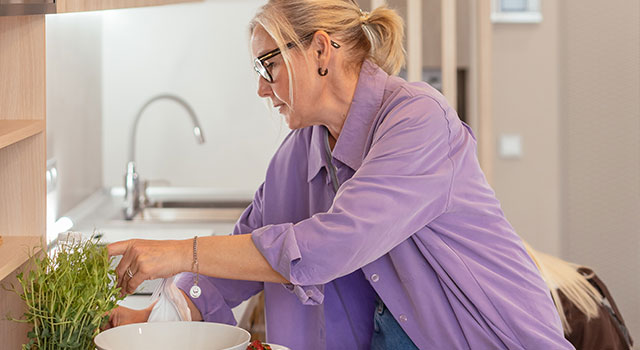 If you have low vision, you know how challenging it can be to cook safely and independently. Just the thought of locating ingredients, chopping, slicing and dicing, and safely using your stove can cause anxiety. Fortunately, with enough planning, practical tips and the right low-vision aids and devices, you can continue to prepare your favorite foods with peace of mind.
If you have low vision, you know how challenging it can be to cook safely and independently. Just the thought of locating ingredients, chopping, slicing and dicing, and safely using your stove can cause anxiety. Fortunately, with enough planning, practical tips and the right low-vision aids and devices, you can continue to prepare your favorite foods with peace of mind.
Your low vision eye doctor at Low Vision Optometry of Central Pennsylvania in Lititz provides guidance and low vision aids and glasses to help you navigate your way through the kitchen and home.
The Importance of Aids, Devices and Support For Low Vision
Not being able to see clearly doesn't just make cooking a meal more complicated. It can also impact your eating habits.
Studies have shown that when everyday tasks like shopping, cooking and food preparation become more difficult due to vision loss, people with low vision tend to change what they eat.
Without the ability to read the names of spices on a spice rack, people with low vision may err on the side of caution and not season their food. Bland food can dull your appetite, leading to poor nutritional intake.
Many people with vision loss also avoid food prep because they're afraid of injuring themselves.
The good news is that with the proper low-vision devices, aids and support, it’s possible to maintain a healthy, happy and independent lifestyle both in and out of the kitchen.
People With Low Vision Can Still Cook
Many of the skills needed to be a good cook are ones you likely already possess, and having low vision doesn’t change that. [By utilizing] your experience and adopting new methods, you can cook safely and effectively.
Here are a few ways to help you or a loved one feel confident in the kitchen:
Organize Your Kitchen
How you set up your kitchen depends entirely on your personal preferences. It's essential to communicate with your family members or cohabitants about where you want appliances and all items to be located so you can easily access everything on your own.
Label Everything
A quick and easy way to label your kitchen items is by encoding similar foods or spices with different colored stickers or even rubber bands. For example, you can use a green rubber band to distinguish between cartons of regular milk and chocolate milk.
Additionally, there are many types of tactile labeling that can help you identify the items in your kitchen and elsewhere in your home.
Good Lighting
The right lighting can make all the difference when it comes to working safely and independently in your kitchen. Your eye doctor can discuss what type of lighting fits your needs.
Use Low-Vision Aids and Devices
Simply using a magnifying device can help you read a food label in the supermarket and assist you in navigating your kitchen.
Low-Vision Devices For Cooking
Below are some low-vision devices that can be used for cooking:
Talking Digital Thermometer with LCD Display
With the push of a button, a talking digital thermometer vocally tells you the temperature in a clear voice. Additionally, large black LCD digits appear on the display. The thermometer can also check the temperature of bath water and other liquids.
Talking Digital Scale
A talking digital scale announces the weight of any item, from rice to flour.
Liquid Level Indicator
Liquid level indicators prevent overfilling and spilling by sounding an alarm when the liquid reaches a certain level. The unit dangles from the cup's edge and will issue a warning to notify the user when the liquid is close to overflowing.
Visit Low Vision Optometry of Central Pennsylvania For All Your Low Vision Needs
While having low vision isn’t easy, it’s possible to live your life to the fullest. With hardware and software updates continuously evolving, it can be hard to decide which to choose.
Let us help. We’ll assess your vision and recommend what aids and devices are best for you and your busy lifestyle.
Make an appointment today with Low Vision Optometry of Central Pennsylvania in Lititz.
We provide assistive aids, devices and glasses for people with low vision.
Our practice serves patients from Lititz, Lancaster, York, and Hershey, Pennsylvania and surrounding communities.
Frequently Asked Questions with Dr. Yanna Nachtigall
Q: How do people who are blind or have low vision use the stovetop?
A: Pay attention to your posture when you stand at the stove. Align your body with the front of the stovetop. Before you start cooking, use the "safety zone" technique to scan the stovetop and ensure that no burners are on: bend your arm so that your forearm is across your chest to detect any unusually hot areas where a flame might be on.
Q: What are the most common types of low vision?
A: There are four general types of low vision:
- Central vision loss: the inability to see objects in the center of your vision
- Peripheral vision loss: the inability to see things in your side vision, often referred to as “tunnel vision”
- Night blindness: difficulty seeing in low light conditions
- Blurry or hazy vision: sometimes described as looking through a dirty or foggy window, where everything appears hazy or out of focus
